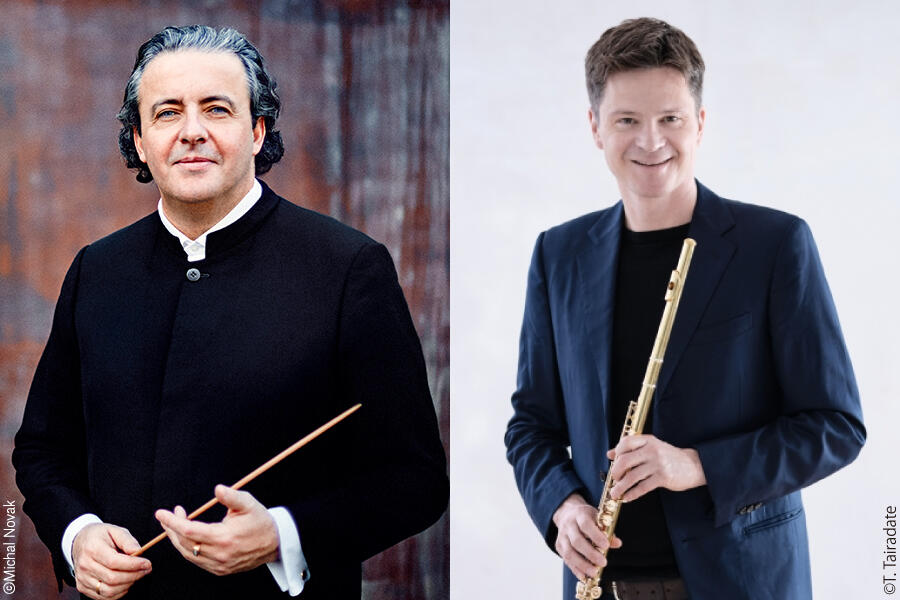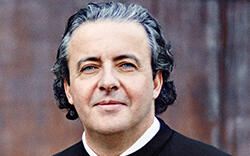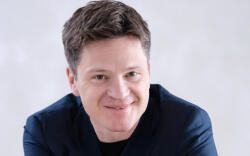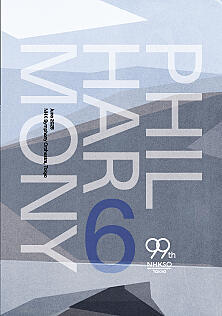- Home
- Concerts
- Subscription Concerts 2024-2025
- Program B
- No. 2040 Subscription (Program B)
No. 2040 Subscription (Program B)

Program
Ibert / Flute Concerto
Born in Paris during the Belle Époque, Jacques Ibert (1890–1962) developed his musical talent early on because of his pianist mother. From 1910, he studied under André Gedalge (Ravel’s teacher) and others at the Paris Conservatoire. It was in Gedalge’s private orchestration class that Ibert met Darius Milhaud (1892–1974) and Arthur Honegger (1892–1955): with Francis Poulenc (1899–1963), Milhaud and Honegger will soon form “Les Six (The Six).” While this avant-garde circle livened up Paris until the early 1920s, Ibert was mostly absent from the capital as he first served in World War I as a nurse and a naval officer, and then won the Prix de Rome (a prestigious art scholarship) to stay in Rome from 1920 to 1923.
Ibert’s renown increased right after this sojourn in Italy. His orchestral piece Escales (Ports of Call)(1922) was premiered in Paris in 1924 to be highly praised, before the immense success of his comic opera Angélique (1927) firmly established his fame in France and abroad. In chamber music, his Three Short Pieces for Wind Quintet (1930) dates from this period.
Considered one of the most important and popular flute concertos alongside Mozart’s No. 1 and No. 2, Ibert’s Flute Concerto was composed in 1932–1933 and dedicated to the legendary French flutist Marcel Moyse (1889–1984). The dedicatee premiered it as the soloist in 1934 with the Orchestre de la Société des Concerts du Conservatoire conducted by Moyse’s teacher Philippe Gaubert (1879–1941) who himself was a distinguished flutist.
Written for the instrument which opens Debussy’s Prélude à l’après-midi d’un faune (1894) and Ravel’s Boléro (1928), Ibert’s Flute Concerto embodies the modern French music with its elegance, clarity, refinement and wittiness while showing his great knowledge of flute’s techniques and expressions. The opening movement in sonata form has the imminent, snaky first theme and the contrastive, calm second theme. The slow second movement gives an exquisite duet by the flute solo and a violin towards the end. The high-spirited virtuosic finale in rondo form starts with the flute solo announcing the recurrent rondo theme with playful triplets.
[Kumiko Nishi]
Bruckner / Symphony No. 6 A Major
The late-Romantic composer Anton Bruckner (1824–1896) was a rare late bloomer in the classical music sphere crowded with infant phenomena. Born near Linz in Upper Austria, he made a living as a schoolteacher and church organist before moving to Vienna in 1868 in his mid-forties. It is only from that moment that most of his representative works including Symphonies No. 2 to No. 9 were penned. He had to long put up with cold treatment of his symphonies until the 1884 successful premiere of No. 7 spread his fame widely, merely twelve years before he passed away in Vienna at age 72.
Bruckner composed the Symphonies No. 2 to No. 5 between 1871 and 1876 before being deeply absorbed in revising works (he even wrote a completely new scherzo for No. 4 in 1878). His only chamber work from his Vienna period, the String Quintet in F major, was finished in July 1879. Penned from September 1879, No. 6 was for him a new symphony to tackle after the previous gap, and it is today considered an important work in the transition to the composer’s final mature period. Incidentally, he set to work on Te Deum, a masterpiece of the sacred music repertoire nowadays, in May 1881 while he was completing No. 6.
As Bruckner didn’t revise No. 6 after the completion, the situation is much simpler than his other symphonies’ with many different versions and editions mostly owing to his frequent large and small modifications. The main reason for that is that No. 6 was partly premiered in 1883 in Vienna (only the second and third movements with large cuts) to be coldly received and then forgotten. It was three years after Bruckner’s death that Gustav Mahler conducted the premiere of all movements in Vienna, but with large cuts and re-orchestration. The entire symphony was first heard in 1901 under the baton of Karl Pohlig in Stuttgart.
All the movements of No. 6 but the third (scherzo) are written as a three-theme sonata (instead of the traditional two-theme), Bruckner’s favorite form. The opening movement begins with the majestic first theme on cellos and contrabasses accompanied by violins’ rhythmical ticks. This theme will return on trombones during the coda of the final movement to end the symphony brilliantly. The slow second movement has, although in F major, a touch of melancholy. The bright, mellifluous second theme first sung by violins and cellos makes a sharp contrast with the third theme in the style of a funeral march. The next movement in A minor is an ABA-form scherzo which is, unexpectedly, less boisterous than Bruckner’s other symphonies’. The trio (central) section B lets horns play a fanfare-like melody before the woodwinds recall the opening theme of Bruckner’s Symphony No. 5 (1878). Horn players will assume a vital role again at the fervent finale, powerfully stating the dotted first theme.
[Kumiko Nishi]
[Encore]
Ibert / Pièce pour Flûte seule
Flute: Karl-Heinz Schütz
Artists
 ConductorJuanjo Mena
ConductorJuanjo Mena
Juanjo Mena is originally from the Basque Country of Spain, where he still lives. The Basque Country has been known as a region of particular ethnicity and culture, but also as the homeland of Ravel (though he was from French side of the region). Partly due to such background, his repertoire was focused on composers of Spain, France and Latin America, including Ravel, however with the development of his career, he expanded his repertoire, and in 2016, he was awarded the Spanish National Music Award, thus advancing as one of the leading maestros to represent Spain. After serving as Artistic Director of Bilbao Symphony Orchestra, Spain (1999–2008), he was appointed Chief Conductor of the BBC Philharmonic of Manchester in 2011 (until 2018), the position of which helped him make his name known internationally, and solidified his reputation not only for his specialism in Spanish music, but also for his symphonic repertoire, including Schubert and Bruckner. He has been repeatedly invited to the world’s famed orchestras for guest-conducting, including the Berliner Philharmoniker.
His first collaboration with the NHK Symphony Orchestra was in 2017, then he returned in 2021, on both occasions, the programs being of Latin and French repertoire. For the coming concert, he has picked Ibert combined with Bruckner, and will exhibit his true value by conducting the expansive Bruckner Symphony No. 6 as he once studied under Celibidache. As he wrapped up the work unstrainedly yet neatly in the recording, we look forward to how the NHK Symphony Orchestra, an orchestra with a long-established tradition for German and Austrian repertoire, will perform the work under his baton.
[Mitsunori Eto, music critic]
 FluteKarl-Heinz Schütz
FluteKarl-Heinz Schütz
Innsbruck-born Karl-Heinz Schütz studied with Eva Amsler at the Vorarlberg State Conservatory in Austria, and then under Aurèle Nicolet, her tutor in Basel, Switzerland. Due to his intention to study in France, Schütz went under the tutelage of Philippe Bernold at the Conservatoire national supérieur musique et danse in Lyon. Thus, he expanded his musical horizons, and won the Carl Nielsen International Competition in 1998, and the International Flute Competition Kraków in 1999. After working with the Stuttgarter Philharmoniker and the Wiener Symphoniker, he joined the Wiener Staatsoper Orchester in 2011, and since 2015, he has been the Principal Flutist of the Wiener Philharmoniker. He also served as soloist in the Wiener Philharmoniker’s subscription concerts, playing Boulez’s Mémoriale and Mozart’s Flute Concerto No. 1. He is a member of the Ensemble Wien-Berlin and the Wiener-Ring-Ensemble.
He previously worked with the NHK Symphony Orchestra in 2015 and 2017, and on this occasion, he will play Ibert’s Flute Concerto. Because he is not only specialized in German and Austrian music, but also French music, he is expected to deliver a highly attractive performance.
[Haruo Yamada, music critic]
Download
Ticket
Program B
No. 2040 Subscription (Program B)
Suntory Hall
Google Map
Seating Chart
Single Tickets Release Date
Pre-sales for Subscribers:Wednesday, February 26, 2025
*about subscribers
Sale to General Public:Sunday, March 2, 2025
Price
| S | A | B | C | D | |
|---|---|---|---|---|---|
| Ordinary Ticket | 12,000 | 10,000 | 8,000 | 6,500 | 5,500 |
| Youth Ticket | 6,000 | 5,000 | 4,000 | 3,250 | 2,750 |
Seating chart Enlarge Print PDF
*tax included
*Subscribers receive a 10% discount (Available at NHKSO WEB Ticket and N-Kyo Guide)
*For wheelchair-accessible seats, please refer to the N-Kyo Guide
Youth Tickets
Youth Tickets are great options for those of 29 years old and younger
Subscription tickets
Release Date
ANNUAL SUBSCRIPTION TICKETS
Mon., July 15, 2024 10:00am
[For Subscribers: Sun., July 7, 2024 10:00am]
Where to buy
NHKSO WEB Ticket | Thursday, June 12 (In English / Seats not selectable)
NHKSO WEB Ticket | Friday, June 13 (In English / Seats not selectable)
NHKSO WEB Ticket (In Japanese only / Seats selectable)
N-Kyo Guide (Purchase by telephone only)
*Repertoire, conductor, soloists and program order are subject to change without notice.
*Pre-school children are not allowed in the concert hall


